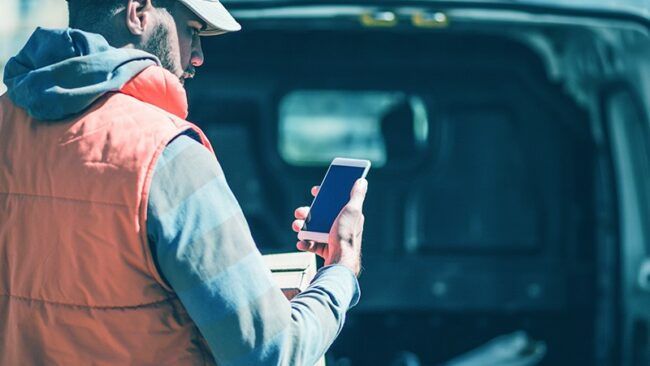Stay connected
Subscribe to our Inside WEX blog and follow us on social media for the insider view on everything WEX, from payments innovation to what it means to be a WEXer.

The payment market that utilizes digital identity is expected to reach $15 billion by 2024, with companies like Google, Apple, and PayPal capitalizing on the moment. What it means for them is an ability to improve the identification verification experience so that it is ever quicker and more secure. What it means for the trucking industry is an even greater focus on fleet security.
The ability to pay for goods and services without using a credit card number has become so prevalent that we don’t even think about it anymore. Usernames and passwords are stored with the payment provider, making it easier and easier to shop as seamlessly as possible. While trucking continues to innovate right along with the rest of the consumer world, its payment processes are a little more complicated. In an industry that is constantly moving, fleet security can be an enormous task, especially where payment is concerned.
While financial institutions have been using digital identity for more than a decade, consumers have only just begun to understand the benefits and opportunities. Pew Research has suggested that the world has more than 5 billion mobile devices, half of them smart phones. Between the Internet and the population’s fascination with social media, digital identities are growing quickly. The trucking industry has come to rely on smart phones for efficiencies in communications and operations, and while mobile devices make payment easier, they also help in numerous ways to maintain fleet security.
The two largest smart phone companies in the world, Samsung and Apple, have been implementing biometric security for some time now. Truckers are using 3D facial scanning along with iris and fingerprint scanning to ensure security in fleet payment. Biometrics in trucking are also helping to save lives. Recently, a division of heavy equipment provider Caterpillar deployed biometrics in their trucks to measure and monitor driver fatigue.
Caterpillar Safety Services, a consultancy arm of Caterpillar, teamed up with Seeing Machines, the company that provides biometric technology. Caterpillar’s trucks can weigh more than 400 tons, and operate in potentially dangerous settings such as mining operations, which often work on a 24-hour clock. Drivers are often working against their natural internal clocks, and the resulting fatigue can have dangerous and potentially fatal consequences if they fall asleep behind the wheel.
— Find Biometrics, Global Identity Management
While digital identity may be moving beyond payment in the consumer category, the trucking industry is still focused on financial fraud detection, which is why many fleet managers and owners are requiring drivers to rely on fuel and fleet cards while utilizing other technologies in combination with smart phones to ensure fleet security.
As fueling technology and fleet management solutions become more robust, companies like WEX are making it harder for criminals to steal vital data. WEX is specifically vigilant in maintaining control and transparency on all fuel transactions, giving carriers control while enhancing functionality and usability. WEX is helping fleet managers to better meet and control time-sensitive employee or contractor payment needs anytime from their mobile device.

Mobile devices and other fleet payment solutions give fleet management secure access to perform critical functions in real time. Actions such as authorization for check cashing or payments, performing overrides, and tracking transactions in real time are critical for both the drivers and the fleet managers in avoiding fraudulent transactions. With these technologies in place, there is never a question of where or how the card is being used.
Secure Fuel: Complete transparency into how your fleet is purchasing fuel—without interrupting your drivers’ operations. SecureFuel uses big data to help identify purchase irregularities and trigger real-time alerts, and ultimately helps you better manage and control your second-largest variable expense.
Data Analytics: Gain visibility into business purchases to find savings, cut costs, and prevent fraud. Find opportunities to cut costs with accurate forecast and fleet expenses. Identify purchasing anomalies and card misuse.
While these techniques may seem obvious, they go a long way in keeping fleet payment secure and drivers safe from fraud.
In an ongoing effort to mitigate fraud, fleet management companies like EFS/WEX also provide powerful card management functionality, including access to real-time credit balances and limits, along with the ability to immediately change the card status to active/inactive/on hold in case of suspicious activity. So, while credit card fraud seems to be pervasive, there are systems and electronic payment solutions in place that can help keep companies and fleet managers feeling more confident in their own fleet security. Digital identity is becoming critical in that effort.
While biotech may be common in smartphone technology and financial institutions, the benefits still seem dubious to many. The number of people happy to rely on conventional username and password security is still large, even if they know it is not the most secure option.
PYMNTS’ Digital Identity Lifestyle Capsule found that 45.2 percent of consumers rely solely on passwords to keep their digital identities safe. And of that 45.2 percent, 73.4 percent said they were “very” or “extremely” satisfied with their current authentication options, indicating a knowledge gap surrounding security best practices.
The study went on to show that 59% of consumers use the same or similar password for most of their accounts, and only 55% of consumers would change their password if they were hacked. Fortunately, smartphone companies and others are forcing the change, and along with fingertip scanning and facial recognition, are offering alternatives that are showing up in the trucking industry as well. PYMNTS.com outlined the three top alternatives to conventional PIN and password or knowledge-based verification.
Facial recognition got a boost when Apple added it (in addition to fingerprint recognition) to the new generation of iPhones. Some facial recognition offerings allow users to upload selfies, which are then compared to 3D facial maps established when users create their accounts.
The downside? Fraudsters can still game the system by using photos of users, and biometrics gets a bad rap due to privacy concerns.
To combat biometric fraud, there is a growing interest in liveliness detection, which requires users to perform defined actions during authentication that are difficult for potential hackers to replicate.

According to the Digital Identity Lifestyle Capsule, consumers reported single-digit percentages for usage of biometric authentication options such as fingerprints, facial recognition, and voice recognition. This low usage reflects the still emergent state of that technology.
Artificial intelligence (AI) is also being used to enhance liveliness detection and is being leveraged for security purposes, such as anomaly detection and the verification of physical identification methods.
Deep learning algorithms can define baselines for typical customer behavior, flagging and reviewing transactions it finds unusual to determine their likelihood of being fraudulent.
The use of AI to verify physical IDs such as drivers’ licenses or passports is still new and can result in false positives. AI can be taught to accept these changes, resulting in fewer false positives, but loosening standards could cause more fake IDs to be accepted.
In addition to AI, banks and fraudsters are using neural networks and other behavior-based learning systems to protect or breach financial systems. While businesses apply neural networks to authenticate customer behavior for identification, cybercriminals can use the same tools to mimic legitimate user behaviors.
The pros of using blockchain for digital ID security are that these systems store data in sequence, making it difficult for fraudsters to access information without leaving evidence – and that consumers can control their own data with blockchain, which is seen as a positive by privacy advocates.
Companies like Microsoft and Fujitsu have been working to develop blockchain-based ID systems to offer greater transparency and security. Blockchain, however, requires a high level of trust among all parties, since no central overseer is involved.
The concerns surrounding digital identity may never be completely alleviated, but the ever-evolving technology is keeping the trucking industry at the cutting edge, with fleet security in better hands than ever.
RESOURCES:
pymnts.com
Subscribe to our Inside WEX blog and follow us on social media for the insider view on everything WEX, from payments innovation to what it means to be a WEXer.